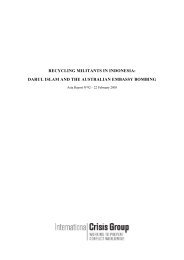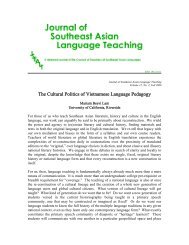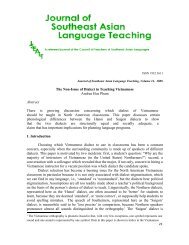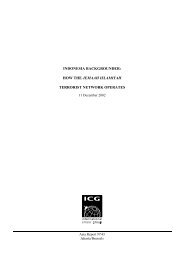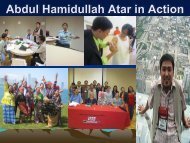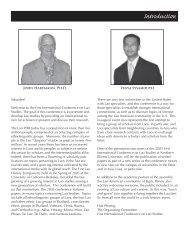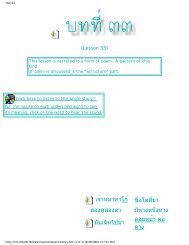jemaah islamiyah in south east asia: damaged but still ... - SEAsite
jemaah islamiyah in south east asia: damaged but still ... - SEAsite
jemaah islamiyah in south east asia: damaged but still ... - SEAsite
You also want an ePaper? Increase the reach of your titles
YUMPU automatically turns print PDFs into web optimized ePapers that Google loves.
Jemaah Islamiyah <strong>in</strong> South East Asia: Damaged <strong>but</strong> Still Dangerous<br />
ICG Asia Report N°63, 26 August 2003 Page 5<br />
with<strong>in</strong> Camp Saddah. 22 Sayyaf provided the land,<br />
arms, and food; the Indonesians had to build the<br />
dormitories; a large kitchen; and tra<strong>in</strong><strong>in</strong>g facilities,<br />
<strong>in</strong>clud<strong>in</strong>g an obstacle course.<br />
The <strong>in</strong>structors for the first two groups were for the<br />
most part Afghans, Pakistanis, and Arabs. Sungkar<br />
appears to have been highly selective about the first<br />
Indonesians he sent. Most were well-educated,<br />
several from prestigious colleges such as Gajah Mada<br />
University <strong>in</strong> Yogyakarta or the Surabaya Institute of<br />
Technology, and they were fluent <strong>in</strong> Arabic or<br />
English. It was tactically smart. For one th<strong>in</strong>g, these<br />
men translated the tra<strong>in</strong><strong>in</strong>g materials, so they became<br />
the <strong>in</strong>structors for the Indonesians who followed.<br />
(Zulkarnaen and Syawal were two of these<br />
<strong>in</strong>structors.) For another, they were of such high<br />
quality that Sungkar’s reputation with Sayyaf was<br />
enhanced, <strong>in</strong>creas<strong>in</strong>g the fund<strong>in</strong>g for recruitment. 23<br />
Camp Saddah was divided <strong>in</strong>to qabilah, the Arabic<br />
word for tribe. The South East Asians were<br />
considered one tribe, so Indonesians, Filip<strong>in</strong>os,<br />
Thais, and Malaysians tra<strong>in</strong>ed together, with a<br />
comb<strong>in</strong>ation of Malay and English as the languages<br />
of <strong>in</strong>struction. There was a Middle Eastern qabilah<br />
for Saudis, Egyptians, and Jordanians, and another<br />
for North Africans, particularly Algerians and<br />
Tunisians. There was not very much <strong>in</strong>teraction<br />
among the different groups.<br />
The full tra<strong>in</strong><strong>in</strong>g program of religious and military<br />
<strong>in</strong>struction was three years, although shorter<br />
courses were available. The religious <strong>in</strong>struction<br />
was very much focused on salafi teach<strong>in</strong>gs, a return<br />
to the pure Islam practiced by the Prophet and his<br />
Companions. It emphasised aqidah (faith), tauhid<br />
(oneness of God) and most of all, jihad, us<strong>in</strong>g<br />
classic salafi texts such as those by Ibn Taymiyya. 24<br />
Abdullah Azzam’s writ<strong>in</strong>gs, also taught <strong>in</strong> the<br />
camp, were a modern echo of Ibn Taymiyya’s<br />
arguments that jihad meant armed struggle and that<br />
it was legitimate to wage such a struggle aga<strong>in</strong>st<br />
Muslims who deviated from the true Islam or<br />
refused to enforce the sharia (Islamic law). These<br />
teach<strong>in</strong>gs would have resonated with Indonesians<br />
from a Darul Islam background, whose efforts to<br />
uphold sharia, let alone establish an Islamic state,<br />
were repressed by the Soeharto government.<br />
One of the Indonesian veterans described the<br />
military component as follows:<br />
First was explosives. We were taught about the<br />
nature of explosives and their chemical<br />
composition. Then we moved on to the<br />
question of detonators, <strong>in</strong>clud<strong>in</strong>g how to blow<br />
up different k<strong>in</strong>ds of targets. Second was<br />
m<strong>in</strong>es: land m<strong>in</strong>es and anti-tank m<strong>in</strong>es. We<br />
studied how to take them apart, how to plant<br />
them, and how to repair them. Of course we<br />
also learned how to shoot and how to drive<br />
tanks. Third was map read<strong>in</strong>g. This was the<br />
part I really loved. We got topography lessons,<br />
learned how to use a compass, and how to draw<br />
contour l<strong>in</strong>es. This is important because if you<br />
are go<strong>in</strong>g to use artillery weapons, you have to<br />
know how to read maps. Fourth was <strong>in</strong>fantry<br />
tactics or war tactics. We studied urban<br />
guerrilla warfare, guerrilla fight<strong>in</strong>g <strong>in</strong> the<br />
mounta<strong>in</strong>s, attacks, ambushes and the like. 25<br />
The third and fourth group of recruits, about 25 men<br />
each, arrived <strong>in</strong> 1987. They were not only able to use<br />
all the facilities built by the first two groups, <strong>but</strong> they<br />
were also the beneficiaries of generous fund<strong>in</strong>g.<br />
Each member reportedly got a monthly stipend of<br />
300 Pakistani rupees, about Rp.30,000 at the 1987<br />
exchange rate or U.S.$15. It was enough to live on,<br />
given that room and board were already covered.<br />
The ceremony welcom<strong>in</strong>g the fourth group was led<br />
by Mustafa Mashur, a top leader of the Egyptian<br />
Muslim Brotherhood whose books have been<br />
widely translated <strong>in</strong>to bahasa Indonesia. Members<br />
of the fourth group also were the beneficiaries of a<br />
new “curriculum” <strong>in</strong>clud<strong>in</strong>g material not taught<br />
before such as sabotage. One <strong>in</strong>structor was an<br />
Egyptian, Muhammad Sauwki al-Istambuli, the<br />
elder brother of one of the killers of Anwar Sadat.<br />
Al-Istambuli, a leader of Gamma al-Islami, had fled<br />
Egypt after the assass<strong>in</strong>ation and come to<br />
Afghanistan around 1983 where he jo<strong>in</strong>ed forces<br />
with Hekmatyar and Sayyaf. In the Sayyaf camp he<br />
was known as a particularly demand<strong>in</strong>g tra<strong>in</strong>er.<br />
“Even the toughest among the Indonesian<br />
mujahid<strong>in</strong> ended up vomit<strong>in</strong>g and fa<strong>in</strong>t<strong>in</strong>g when<br />
they were tra<strong>in</strong>ed by him”, a veteran recalled.<br />
Zulkarnaen, the man who became JI’s military<br />
leader, was a particular protégé. 26<br />
22 ICG <strong>in</strong>terview with Afghanistan veteran, March 2003.<br />
23 Ibid.<br />
24 ICG <strong>in</strong>terviews, March and June 2003.<br />
25 ICG <strong>in</strong>terview, March 2003.<br />
26 ICG <strong>in</strong>terview, March 2003.






